|
WBS Operations
|   |
This section contains information on various operations that can be carried out on the WBS. The menu listing the operations that can be carried out on the WBS is displayed when mouse is hovered above the WBS button. WBS Operations menu is displayed below.
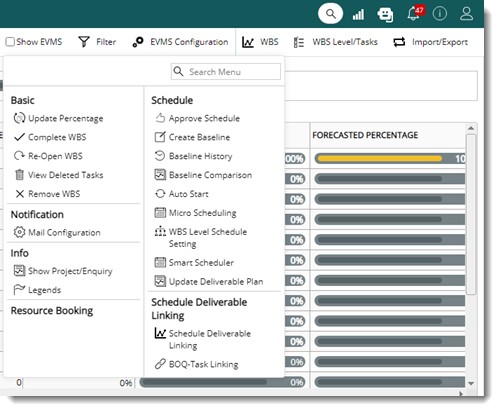
Figure: WBS Operations menu
Details on operations that can be carried out from the WBS menu can be explored using this navigation table.
Navigation Table
|
To |
See |
|
Schedule the tasks in the WBS |
|
|
Complete the WBS |
|
|
Re-open a completed WBS |
|
|
Preserve a snapshot of the current plan |
|
|
View old baselines of the WBS |
|
|
Update percentage progress of tasks in bulk |
|
|
View details of project for the current WBS |
|
|
Configure mail notifications |
|
|
Auto-initiate all tasks in WBS |
|
|
View tasks removed from WBS |
|
|
Delete the WBS |
|
|
Create and manage Project Master Schedule |
|
|
Schedule deliverable linking |
|
|
Update Deliverable Plan |
Prior to starting the project, the planning team creates the Master Deliverable List (MDL) and primary schedule for Master Deliverable List (MDL). MDL contains whole list of deliverables related to this Project. This is carried out using WRENCH. The schedule is finalized after approval by the project team and then the client. When the project schedule is finalised and it is ready to start the work the tasks in the MDL is scheduled. Approve Schedule option is used to schedule the MDL or WBS.
On clicking the Approve Schedule option, all the unscheduled tasks in the WBS are scheduled and baselined. If there are WIP and scheduled tasks in the WBS they are unaffected by this operation.
The following message is displayed.
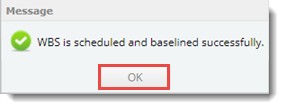
Task status is changed to Scheduled.
NOTE: You need to have Edit WBS permission to carry out this operation.
After all the tasks in the WBS is completed, the WBS can be completed using this option. Once the WBS is completed, no new tasks can be added to the WBS nor can the task schedules be edited. If there are any incomplete tasks in the WBS, a warming message is displayed.
Completed WBS can be re-opened using this facility. Once a WBS is re-opened, different WBS operations can be carried out on the WBS.
Baseline-WBS is the process of preserving a “snapshot” of the current plan so that changes can be made to it without losing the current state. Such “Snapshots” can later be viewed and compared to assess the efficiency of project planning.
Once you baseline the WBS:
When the WBS is baselined old baseline details are maintained by the system. A list of such old baseline details will be available in the Baseline History. The history of baselines the WBS has undergone is displayed here. In the baseline history window the following fields are displayed.
|
# |
Property |
Description |
|
1 |
Baseline Number |
Issue number helps in identifying the version of the WBS and if it is the latest version. |
|
2 |
Baseline Comments |
The cause of baseline entered by the user while baselining the WBS is displayed here. |
|
3 |
Baselined By |
Name of the user who carried out the WBS baseline operation is displayed here. |
|
4 |
Baselined On |
Date on which the WBS was baselined is displayed here. |
|
5 |
WBS Name |
Name of the WBS is displayed here. |

Figure: WBS Baseline History
The baseline history can be exported to MS Excel. In the Baseline History window click Expot to Excel to export the baseline history.
This option is used to update the percentage of progress of tasks in bulk, when the area weightage has been edited in the project or when the weightage/schedule details have been edited for tasks and the progress according to the changes needs to reflect in the WBS.
Progress of the summary task is updated automatically as the child tasks are updated.
On clicking this option Project Details page is displayed with the details on project of current WBS.
Email notifications are sent after different WBS operations for informing user about the action they have to take. Subject and content of these mails can be pre-defined. Notification mails can be configured for different Task or Rule related actions or events.
 To configure notification mails
To configure notification mails
You can auto-start or auto-initiate all the tasks in WBS using this option.
To auto-start tasks in the WBS
Auto Initiation window is displayed.
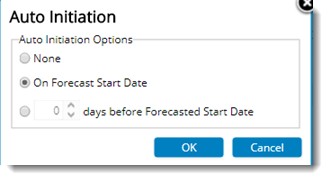
Figure: Auto Initiation window
The following options are available in the window.
None: On selecting the radio button next to this option, any existing auto-start settings are cancelled.
On Forecast Date: On selecting the radio button next to this option, all tasks in WBS will be scheduled to start their workflows on the forecast date.
"__" days before Forecast Start Date: Use this option to set number of days before forecasted date on which task workflows has to be started automatically.
After selecting the options to start the tasks automatically, if the workflow fails to start on scheduled dates an alert mails is sent to the user who edited the task last and to the project manager with the details of the task that failed to start.
NOTE: This email can be pre-formatted using Mail Configuration option.
When tasks are removed from a WBS, they are preserved for future reference. On clicking this option Deleted Tasks window is displayed. Tasks deleted from the WBS is displayed here.
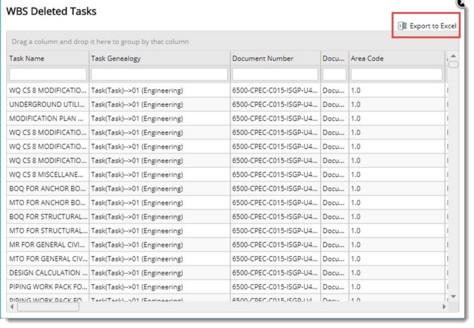
Figure: Deleted tasks
An option to export the details of deleted tasks to MS Excel is available. All available task properties are exported to excel in a pre-defined format.

Figure: Warning Message - Removing WBS
Micro Scheduling
Micro scheduling is the operation in which the schedules for each rule in rules of credits assigned to tasks can be computed automatically, based on formulae defined in the project. For more information on this topic see Working from Task Details window>>Schedules>>Microscheduling
Smart Scheduler in SmartProject helps you in creating and managing Project Master Schedule or plans and oraganize, assign and collaborate on tasks. Schedule is created as WBS Level and Tasks along with other WBS task properties. Successor and predecessor relationship details can be specified for each task in Smart scheduler. The Project Scheduling feature in SmartProject provide Forecast Finish date to Project Plan and show critical activities to Planner. Auto scheduling operation may be performed to determine the Early/Late Start/Finish of each tasks and identify critical tasks. Critical path method can be used by constructing a model of the Project that includes the following.
With this information, you can determine the critical path by identifying the longest stretch of dependent activities and measuring them from start to finish.
Defining WBS Level/tasks as Schedule type
WBS Levels and Tasks can be selected and marked as Schedule type of tasks.
 To mark WBS Levels/Tasks as schedule type
To mark WBS Levels/Tasks as schedule type
After saving the WBS Schedule settings next step is to open the smart scheduler.
Tasks and Levels can be added in the smart scheduler window.
Though start and finish dates are populated automatically based on the Project start and end dates, new dates can be defined.
 To enter start and finish dates
To enter start and finish dates
If Forecast start and Forecast finish date is available, duration will be calculated automatically. Existing duration of an activity can be modified. Value in the column Duration can be edited manually.
Task information of tasks in the smart scheduler can be modified.
 To modify task details and schedules
To modify task details and schedules
Successor, Predecessor relationships can be defined between different tasks in Smart Scheduler. Relationships can be defined only for ‘Schedule’ Type tasks; hence this operation is only possible from the Smart Scheduler window.
For each task in Smart scheduler, successor /predecessor dependency can be specified from the Successor/Predecessor columns in smart scheduler. A dependency is the relationship between predecessor and successor tasks.
Standard dependency types used in Smart Scheduler is mentioned in the following table.
|
# |
Type |
Abbreviation |
Remarks |
|
1 |
Finish to Start |
FS |
Activity 1 must finish before activity 2 can start. |
|
2 |
Finish to Finish |
FF |
Activity 1 must finish before activity 2 can finish. |
|
3 |
Start to Start |
SS |
Activity 1 must start before activity 2 can start. |
|
4 |
Start to Finish |
SF |
Activity 1 must start before activity 2 can finish. |
In some cases, the Successor activity can be started only after certain number of days after completion of the Predecessor. This is called the Lag time. Lag is the delay of a successor activity and represents time that must pass before the second activity can begin.
Predecessors of task can be defined in the Smart Scheduler grid.
 To define predecessor of a task
To define predecessor of a task
For defining successors of a task, applicable task relationships may be entered against the successor column of Smart scheduler. Format for specifying dependencies/relationships is similar to that in defining Predecessor.
Constraints can be used to create a link between a task and a particular date. By default, all tasks are created with the Constraint type 'As Soon As Possible' set. This allows Smart Scheduler to schedule the task based on its duration and dependencies, rather than against a particular date.
Sometimes it is required to prevent Smart Scheduler from rescheduling a task away from a key date. For example, imagine you are managing the review of a Project. The date of the review is likely to have been booked for months and is probably immovable. In this instance you might set a ‘Must start on’ project constraint for the date of the review.
In case ‘Review day’ has other tasks linked to it Smart Scheduler will warn you that a constraint might cause a future scheduling conflict.
Additional Information
Here Relationship or dependency already defined is displayed.
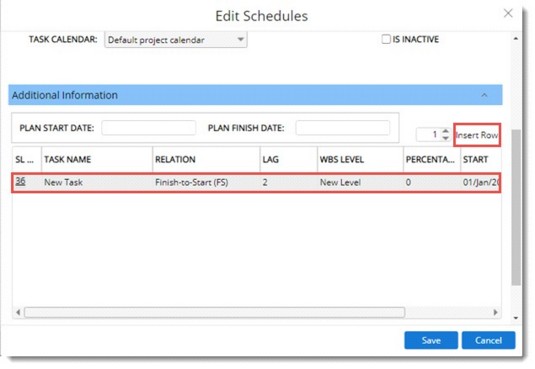
Figure: Additional Information
It is possible to edit TASK NAME, RELATION and LAG.
If there are any SUCCESSOR tasks defined, they are displayed in the section Successors.
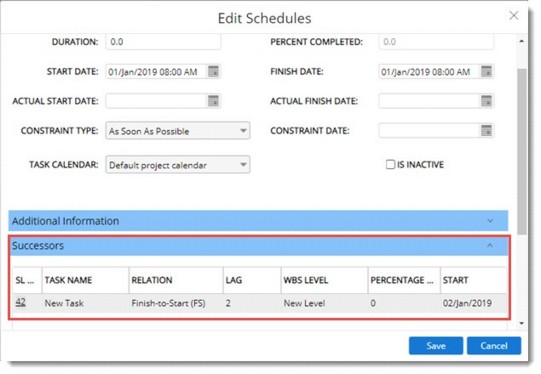
Figure: Successor task details
If there are any tasks related to the selected task, they are displayed in the section Related Tasks.
The critical path is composed of those tasks whose finish dates affect the finish date of the overall project. In other words, if a critical task finishes late, the project will likely finish late also, unless you are able to adjust to the delay and make up time elsewhere. The Critical Path is the series of tasks that must finish on time for the entire project to finish on schedule. Each task on the critical path is a time critical task.
In Smart Scheduler option to auto schedule with critical path is provided. This option is displayed only if the Smart Scheduler is not in edit mode.
Incomplete tasks in a WBS can be rescheduled from a new date.
The following operations can be carried out from the window.
Add Task: Click this option to add against default task Genealogy. If there is no default task genealogy, mandatory properties against default genealogy, a warning message is displayed.
Add Level: On clicking this option after selecting a task, a new Level can be added below or above the task.
Remove Task /Level: On clicking this option after selecting a row, the selected Level or Task is removed.
Indent: On clicking this option the selected level moves inside by one step.
Outdent: On clicking this option the selected level moves outside by one step.
Move: Options to move the selected Level up or down is available here.
Copy: Click this option to copy the selected level.
Paste: Click this option to paste the copied level.
Make Inactive: On clicking this option after selecting a task, selected tasks are made inactive. The relationship with an inactive task will not be considered if they are available in other tasks
Make active: On clicking this option after selecting inactive tasks, the tasks are made active.
Expand All: Click this option to expand all Levels/Tasks
Collapse all: Click this option to Collapse all Levels/ Tasks.
Reset Changes: Click this option to discard any unsaved changes and display the last saved information in the smart scheduler.
Save/Check-in: Click this option to save the information to WBS.
Unlock WBS: Click this option to unlock the WBS.
Exporting and updating tasks from the Smart scheduler
Tasks can be exported and updated from the smart scheduler

To export the tasks
Bulk Export Wizard is displayed. Export operation is similar to other export operations available in the WBS. Hence it is not explained in detail.
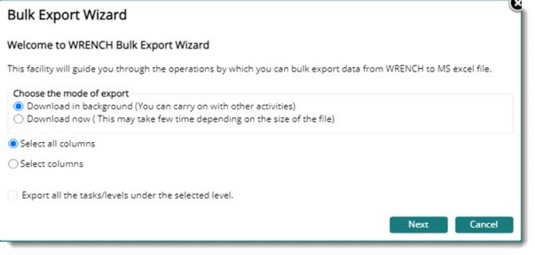
Figure: Bulk Export Wizard window
NOTE: If the checkbox next to the option, Export all the tasks/levels under the selected level is selected, then the user is permitted to export all the tasks, and sub-levels that are present under the selected levels. This option is enabled only if the selection contains at least one level for export.
If the option Select all Columns is selected, details are exported to an MS Excel file.
If the option Select Columns is selected, on clicking Next, a column selection window is displayed.
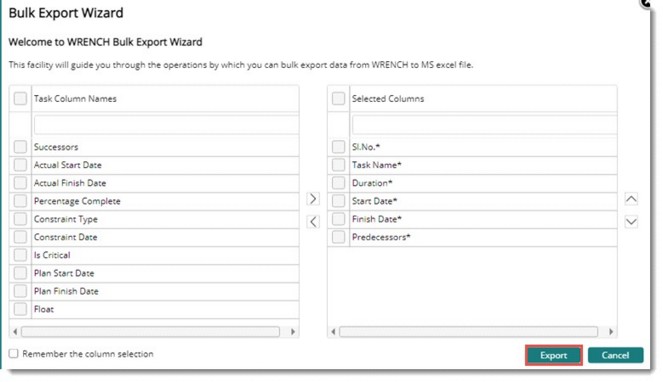
Figure: Select columns window
The selected columns and values in the columns are exported to an MS Excel template.
After exporting the task details to the MS Excel template, make the necessary modifications in the Excel; add data in blank cells, modify the existing data, remove unwanted data from the cells, etc.
Once the necessary modifications are done, save the Excel and update it back to SmartProject.
To import modified task details to SmartProject
A file selection window is displayed.
If there are no errors, the bulk update operation is completed successfully, and a notification is sent to the logged-in user.
To view the log of operations
The Bulk Operation Log window is displayed.
Here a log of the bulk operations and its status is displayed.
Legends
Different properties and statuses in the WBS is depicted by different colours. This helps in recognizing different WBS statuses, progress and other properties. On clicking the legends the following window is displayed.
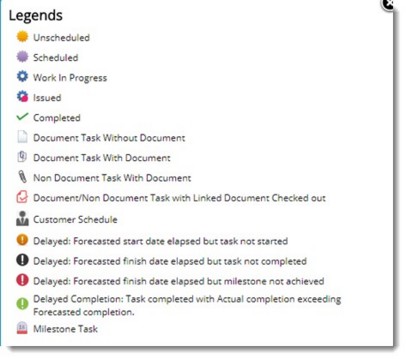
Figure: Legends
Scheduling deliverable linking
In large construction projects, the planning team creates the top-level project plan which consist of the L1 or L2 schedule. This schedule may not have the complete list of tasks but a summary, which can be broken down into various sub tasks. These sub tasks are the ones that can be monitored for progress, which needs to be rolled up to the plan.
Here, the schedule as created by the planning team is called the ‘Schedule’ or simply ‘Tasks’ and the detailed list of sub tasks are termed ‘Deliverables’ (because these are the actual work that is delivered).
For Example, consider the following project plan:
ABC Township
-> Generator Unit 1
-> ROW Tower 2
-> Desalination plant
-> Engineering
-> Civil
-> Helipad Offshore Rig
The ‘ABC Township -> Desalination plant -> Engineering -> Civil’ is a typical ‘Schedule’. This task will be assigned to the civil department where it is further broken down into different deliverables (document list), each of which will be assigned with a plan of completion. When each of the deliverable’s progress, it must contribute progress to the ‘Civil’ task in the ‘Schedule’.
To achieve this, it is required to link the schedules to corresponding deliverables. Large construction projects will have thousands of tasks and linking them manually is a Herculean task. In SmartProject it is possible to link schedules to deliverable automatically
NOTE: For updating the actuals of the schedule with the actuals from the deliverables, the schedules must be linked with deliverables.
 To open schedule deliverable linking window
To open schedule deliverable linking window
Schedule tasks can be selected from a parent schedule task and task genealogy.
 To select schedule tasks from parent schedule tasks
To select schedule tasks from parent schedule tasks
 To select schedule tasks from schedule task genealogy
To select schedule tasks from schedule task genealogy
NOTE: If PARENT SCHEDULE TASK and Schedule Task Genealogy is selected, then the tasks are filtered based on the combination and displayed.
Selecting deliverables for linking
Deliverables under a parent deliverable task or deliverable task genealogy can be selected and linked to schedule tasks.
 To select deliverables under a parent deliverable task
To select deliverables under a parent deliverable task
 To select a deliverable under a deliverable task genealogy
To select a deliverable under a deliverable task genealogy
Linking schedules and deliverables
After selecting the schedule tasks and deliverable tasks, next step is to link the deliverables and schedules.
 To link a deliverable to selected schedule task
To link a deliverable to selected schedule task
Delinking deliverables from schedules
‘Linked Deliverables’ can be de-linked from the list.
 To de-link deliverable from schedules
To de-link deliverable from schedules
Linking schedules and deliverables automatically
Schedule-deliverable linking can be carried out automatically using rules.
 To automatically link schedules and deliverables
To automatically link schedules and deliverables
In some scenarios, it is more convenient to link a single BOQ to all that tasks .
In typical construction projects, project schedules (Schedule Tasks) are created with a high degree of planning (high-level plan). For each of these schedules, the deliverables are created separately by the people who work on the deliverables. The deliverable plan is to be in sync with the corresponding schedules (all deliverables linked to a schedule must be completed within the schedule’s plan). Plan date of scheduled tasks can be automatically updated to all linked deliverables by default so that the planners can modify the schedule dates where required.
To update deliverable plan
Update Deliverable Plan window is displayed.

Figure: Update Deliverable plan window
The elements in the window are explained in the following table.
|
# |
Property |
Description |
|
1 |
Scope |
Select the type of linking based on which the plan from schedules needs to be updated to the deliverables. Options Task to task linking and Task to rule linking are displayed in the window. Select the radio button next to the required option. |
|
2 |
SCHEDULE PROPERTY NAME |
Select the date which needs to be updated from the schedules to deliverables from a drop-down list. Dates displayed in the list are Planned Dates, Forecasted Dates, Early Dates, Late Dates, Internal Dates. |
|
3 |
DELIVERABLE PROPERTY NAME |
Select the date to which the schedule dates need to get updated from a drop-down list. |
|
4 |
Add Property |
Click the option Add Property to add additional properties for updating the scheduled deliverable plan. |
|
5 |
Remember the selection |
If the checkbox next to this option is selected, then if the user re-enters the ‘Update Deliverable Plan’, the last defined properties are loaded in the window. |
The system verifies the Schedule Property (Date) and its corresponding Deliverable Property (Date). Once these dates are identified, the dates specified in the ‘Schedule Property Name’ are updated to the dates specified in the ‘Deliverable Property Name’.
In the list of values for the property DELIVERABLE PROPERTY NAME, value Internal Dates is not listed if the option Task to rule linking is selected. This is because internal dates do not apply to the rule of credit.
If the option Task to task linking is selected, on clicking Update, the planned date, forecasted date, early date/ and late dates of the linked schedule tasks get updated against the Planned date, Forecasted date, Early date, and late date of the linked deliverables.
If there are multiple deliverables linked against a scheduled task, then on updating schedule dates to deliverables, the planned, forecasted, late, and early dates of the linked deliverable rules get updated with the linked schedule’s planned, forecasted, late, and early.
When multiple schedules are linked to a single deliverable, then on updating the schedule plan to deliverables, the Minimum of the plan/forecast/late/early/internal start dates of the linked schedule get updated into the respective plan/forecast/late/early/internal start dates of the deliverables, and the Maximum of the plan/forecast/late/early/internal finish dates of the linked schedule get updated into the respective plan/forecast/late/early/internal finish date of the deliverables.
If the option Task to rule linking is selected on successful updating, the planned/forecasted/early/late finish dates of the linked schedule tasks get updated against the linked deliverable rules’ Planned/forecasted/early/late finish dates because rule of credit only have finish dates.
If there are multiple deliverable rules linked against a scheduled task, then on updating schedule dates to deliverables, the planned, forecasted, late, and early finish dates of the linked deliverable rules get updated with the linked schedule’s planned, forecasted, late, and early finish dates.
When multiple schedule tasks are linked to a single rule, then on performing the update operation, the Maximum of the plan/forecast/late/early finish dates of the linked schedule tasks get updated into the plan/forecast/early/late finish date of the linked deliverable rule.
When the update operation is completed, a success message is displayed.